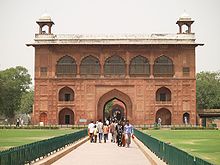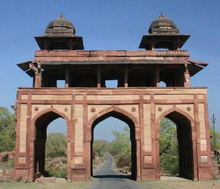- Naqqar khana
-
Naqqar khana (Hindi: नक़्क़ार ख़ाना, Urdu: نقّار خانہ) or Naubat khana (Hindi: नौबत ख़ाना, Urdu: نوبت خانہ) is a term for a drum house or orchestra pit during ceremonies. They are a distinct sign of Mughal architecture. They are found in India, Pakistan, and other nearby countries. The name comes from Naqqar or Naubat meaning Shehnai and khana means 'a place related to', thus Naubat khana means a place where Shehnai is performed.
 Naqqar khana in Red Fort
Naqqar khana in Red Fort
In Red Fort in Delhi, on the eastern side of the ten pillars lane, was the main entrance and a pavilion where royal palanquins and other paraphernalia were placed. There was another pavilion housing 18 kinds of musical instruments that used to form part of the royal entourage. This pavilion was named Naubatkhana and was dilapidated until 100 years ago. The Naubatkhana was in such disrepair during the last century that the American Mission declined to take it as a gift, and then it was restored by George Fisher in 1858 for the new Zilla School. Naubatkhana also was used for some time as the police headquarters. Now the building serves as a middle school facility for the Sourastra Community.
The construction of the palace was completed in 1636. During 1659 it suffered damage by the ruler of the time, the grandson of the carpenter Thirumalai Naick. His grandson Chockanatha Naick, in order to carry the materials to Trichy to establish a new palace, pulled down some of the portions like Rangavilasam. The throne, costly jewels, and other valuable treasures were taken to Trichy. The materials were not utilized at Trichy, and no palace was constructed. Much of the rest of the palace disappeared. In the last century, a part of the building to the west of the celestial pavilion collapsed under a heavy rainstorm. People encroached upon much of the palace, and they converted it into their homes.
Bharat Ratna Bismillah Khan's family had played shehnai for generations in Naubatkhana, which overlooked palaces and temples, and enabled their music to be heard across the countryside.
Gallery
-
Naubat Khana at Bara Imambara, Lucknow

This Asia-related article is a stub. You can help Wikipedia by expanding it. -


